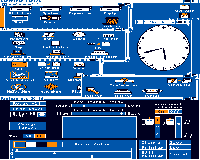Workbench general
 The Workbench is the graphical user interface (desktop) of the Amiga operating systems. The different versions are listed →here.
The Workbench is the graphical user interface (desktop) of the Amiga operating systems. The different versions are listed →here.
The Amiga's operating system (AmigaOS) was delivered in several parts on floppy disks with the first Amiga (the Amiga 1000). The first disk required for booting was called Kickstart and contained the operating system kernel, the DOS and some system libraries, which also included the necessary graphics components. The second diskette was called Workbench, after booting with this diskette the system was available.
The entire Amiga operating system therefore initially fitted on two floppy disks, the Kickstart disk (on which 256 KB were written) and the Workbench disk with 880 KB capacity.
Later Amiga models (from the Amiga 500 and Amiga 2000 released in 1987) had the contents of Kickstart in ROM, only the Workbench diskette had to be loaded. Amiga users still use this distinction (the ROM is Kickstart, everything else loaded from a disk is Workbench), although it is not entirely accurate, as the division of the system components between ROM and hard disk changed considerably in later versions of the operating system.
Features
AmigaOS - and thus also the Workbench - offers a graphical user interface in color, with multitasking and relatively short response times, e.g. to user input. The part of AmigaOS for realizing the graphical user interface is called Intuition, which is the first application to implement the user desktop called Workbench. Intuition provides elements such as icons (in Amiga German “Piktogramm”), Windows (windows) etc. As with other operating systems, the Workbench is used for the graphical version of a command line, i.e. for file management and program calls, as well as for window management in general. However, the entire system is so flexible that applications can also make use of basic features such as windows and other graphic elements without loading the workbench.
The input fields, buttons and click boxes in Intuition windows are called gadgets (Germanized “symbols”) on the Amiga.
The lack of partitioning of the processes under AmigaOS (“memory protection”) enabled fast inter-process communication by simply passing pointers without copying data, but this meant that any program could crash the entire system in the event of an error. The speed of the OS was even increased over the years through various improvements - in contrast to the competition.
AmigaOS, the operating system of the Amiga, is also modular and has various similarities to concepts known from UNIX. The Amiga has dynamically reloadable device drivers (suffix: .device) as well as shared libraries (suffix: .library) and supports many concepts of modern operating systems (streams, pipelining, signals, message queues, etc.). The command line interpreter (Shell/CLI) known from Unix and Linux is also not foreign to the Amiga.
The AmigaOS has offered a permanent and dynamic RAM disk since 1986. Later there was even the option of including a reset-proof RAM disk, which was bootable and was available with all previously loaded data after a restart. The RAM disk made it possible to speed up applications enormously, as the slow access to floppy disks or hard disks was no longer necessary.

Links
- to verification sources
- to documentation
- Software updates